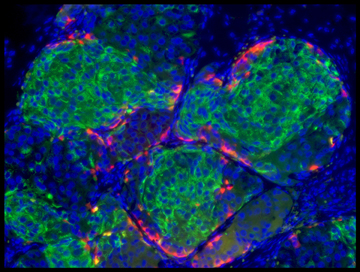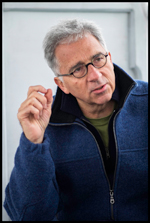
Harvard stem cell researchers have made a giant leap forward in the quest to find a truly effective treatment for Type 1 diabetes, a condition that affects an estimated three million Americans at a cost of about $15 billion annually.
With human embryonic stem cells as a starting point, the scientists are for the first time able to produce, in the massive quantities needed for cell transplantation and pharmaceutical purposes, human insulin-producing beta cells that are equivalent in almost every way to normally functioning beta cells.
Douglas Melton, who led the work and who 23 years ago, when his infant son Sam was diagnosed with Type 1 diabetes, dedicated his career to finding a cure for the disease, said he hopes human transplantation trials using the cells will be under way within a few years.
“We are now just one preclinical step away from the finish line,” said Melton, whose daughter Emma also has Type 1 diabetes.
A report on the new work is published in the journal Cell.
Felicia Pagliuca, Jeffrey Millman and Mads Gurtler of Melton’s lab are co-first authors on the Cell paper. The research group and paper authors include Michael Segel, who was a Harvard undergraduate when the work was done.
“You never know for sure that something like this is going to work until you’ve tested it numerous ways,” said Melton, Xander University Professor of Stem Cell and Regenerative Biology and co-chair of the Department of Stem Cell and Regenerative Biology. The department is jointly administered by Harvard Medical School and the Faculty of Arts and Sciences. “We’ve given these cells three separate challenges with glucose in mice, and they’ve responded appropriately; that was really exciting.
“It was gratifying to know that we could do something that we always thought was possible,” continued Melton, “but many people felt it wouldn’t work. If we had shown this was not possible, then I would have had to give up on this whole approach. Now I’m really energized.”
The stem-cell-derived beta cells are currently undergoing trials in animal models, including non-human primates, said Melton, who is also a Howard Hughes Medical Institute investigator.
Elaine Fuchs, the Rebecca C. Lancefield Professor at The Rockefeller University and a Howard Hughes Medical Institute investigator, hailed it as one of the most important advances to date in the stem-cell field and added “I join the many people throughout the world in applauding my colleague for this remarkable achievement.” She was not involved in the work.
“For decades, researchers have tried to generate human pancreatic beta cells that could be cultured and passaged long term under conditions where they produce insulin. Melton and his colleagues have now overcome this hurdle and opened the door for drug discovery and transplantation therapy in diabetes,” Fuchs said.
Jose Oberholzer, professor of surgery, endocrinology and diabetes, and bioengineering; director of the Islet and Pancreas Transplant Program; and chief of the Division of Transplantation at the University of Illinois at Chicago, said work described in today’s Cell “will leave a dent in the history of diabetes. Doug Melton has put in a lifetime of hard work in finding a way of generating human islet cells in vitro. He made it. This is a phenomenal accomplishment.”
Melton, co-scientific director of the Harvard Stem Cell Institute—created more than a decade after he began his quest—said that when he told his son and daughter, they were surprisingly calm. “I think, like all kids, they always assumed that if I said I’d do this, I’d do it,” he said with a self-deprecating grin.

Type 1 diabetes is an autoimmune metabolic condition in which the body kills off pancreatic beta cells that produce the insulin needed for glucose regulation in the body. The final preclinical step in the development of a treatment involves protecting from immune-system attack the approximately 150 million cells that would have to be transplanted into each patient being treated. Melton is collaborating on the development of an implantation device to protect those cells with Daniel Anderson, the Samuel A. Goldblith Professor of Applied Biology, associate professor in the Department of Chemical Engineering and at the Institute of Medical Engineering and Science, and member of the Koch Institute for Integrative Cancer Research at MIT.
Melton said that the device Anderson and his colleagues at MIT are currently testing has thus far protected beta cells implanted in mice from immune attack for many months. “They are still producing insulin,” Melton said.
Cell transplantation as a treatment for diabetes is still essentially experimental, using cells from cadavers, requiring the use of powerful immunosuppressive drugs, and having been available to only a very small number of patients.
MIT’s Anderson said the new work by Melton’s lab is “an incredibly important advance for diabetes. There is no question that ability to generate glucose-responsive, human beta cells through controlled differentiation of stem cells will accelerate the development of new therapeutics. In particular, this advance opens doors to an essentially limitless supply of tissue for diabetic patients awaiting cell therapy.”
Richard A. Insel, chief scientific officer of JDRF, formerly known as the Juvenile Diabetes Research Foundation, a funder of Melton’s work, said “JDRF is thrilled with this advancement toward large-scale production of mature, functional human beta cells by Dr. Melton and his team. This significant accomplishment has the potential to serve as a cell source for islet replacement in people with Type 1 diabetes and may provide a resource for discovery of beta-cell therapies that promote survival or regeneration of beta cells and development of screening biomarkers to monitor beta cell health and survival to guide therapeutic strategies for all stages of the disease.”
Melton expressed gratitude to both JDRF and the Leona M. and Harry B. Helmsley Charitable Trust, saying “their support has been, and continues to be, essential.”
While diabetics can keep their glucose metabolism under general control by injecting insulin multiple times a day, that does not provide the kind of exquisite fine-tuning necessary to properly control metabolism, and that lack of control leads to devastating complications from blindness to loss of limbs.
About 10 percent of the more than 26 million Americans living with Type 2 diabetes are also dependent upon insulin injections and would presumably be candidates for beta cell transplants, Melton said.
“There have been previous reports of other labs deriving beta-cell types from stem cells, but no other group has produced mature beta cells as suitable for use in patients,” he said. “The biggest hurdle has been to get to glucose-sensing, insulin-secreting beta cells, and that’s what our group has done.”
In addition to the institutions cited above, the work was funded by the Harvard Stem Cell Institute, the National Institutes of Health, the JPB Foundation, and Mike and Amy Barry.
Adapted from a Harvard Stem Cell Institute news release.


